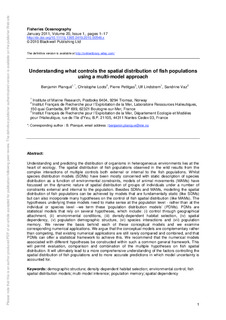| dc.description.abstract | Understanding and predicting the distribution of organisms in heterogeneous environments lies at the heart of ecology. The spatial distribution of fish populations observed in the wild results from the complex interactions of multiple controls both external or internal to the fish populations. Whilst species distribution models (SDMs) have been mostly concerned with static description of species distribution as a function of environmental constraints, models of animal movements (MAMs) have focussed on the dynamic nature of spatial distribution of groups of individuals under a number of constraints external and internal to the population. Besides SDMs and MAMs, modelling the spatial distribution of fish populations can be achieved by models that are fundamentally static (like SDMs) but can also incorporate many hypotheses on the control of fish spatial distribution (like MAMs). The hypotheses underlying these models need to make sense at the population level - rather than at the individual or species level –we term these ‘population distribution models’ (PDMs). PDMs are statistical models that rely on several hypotheses, which include: (i) control through geographical attachment, (ii) environmental conditions, (iii) density-dependent habitat selection, (iv) spatial dependency, (v) population demographic structure, (vi) species interactions and (vii) population memory. We review the basis behind each of these conceptual models and we examine corresponding numerical applications. We argue that the conceptual models are complementary rather than competing, that existing numerical applications are still rarely compared and combined, and that PDMs can offer a statistical framework to achieve this. We recommend that the numerical models associated with different hypotheses be constructed within such a common general framework. This will permit evaluation, comparison and combination of the multiple hypotheses on fish spatial distribution. It will ultimately lead to a more comprehensive understanding of the factors controlling the spatial distribution of fish populations and to more accurate predictions in which model uncertainty is accounted for. | no_NO |
